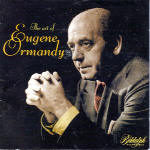This well-programmed and excellently produced reissue traces the progression of Eugene Ormandy’s early career from Broadway pit orchestra violinist and conductor to music director of the Minneapolis and Philadelphia Orchestras. In his book The Other Side of the Record, Charles O’Connell recalled Ormandy picking up the fiddle for the first time in years and launching into an impromptu reading of the Bach Chaconne, to impressive effect. Within their limited scope, the five encore-type pieces that open Disc One indeed confirm a major violin talent. Yet Ormandy was clearly born to conduct. Even the lightweight selections featuring a studio “Salon Orchestra” and a kitsch-laden arrangement of Sam Coslow’s “Was It A Dream” with the Dorsey Brothers Concert Orchestra bear the stamp of a firm podium presence who could be counted on to deliver the goods.
Ormandy’s Minneapolis tenure bore fruit in the form of valuable recorded premieres, such as Zemachson’s Chorale and Fugue in D Minor, Zador’s Hungarian Caprice (a delectable work, this!), and Griffes’ evocative The Pleasure Dome of Kubla Khan. Roy Harris’ When Johnny Comes Marching Home: An American Overture gets a particularly bracing performance, probably due to the conductor only having received the score the morning of the session. By all accounts, he arrived at the studio and conducted it from memory. Disc one concludes with Ormandy’s splendid, lithe Philadelphia readings of Barber’s First Essay for Orchestra and Menotti’s overture to Amelia Goes to the Ball, in their first recordings.
The second disc offers several first recordings of larger-scaled works. Mark Obert-Thorn’s restoration of Miaskovsky’s Symphony No. 21 is effected as well as it can be from commercial source disc material. Do the original 1947 lacquers repose in Sony’s vaults? Would they yield less constricted sound? Nevertheless, no sonic problems beset Richard Strauss’ Sinfonia domestica. Ormandy’s 1938 RCA recording was well-recorded for its time, and the disciplined wind and brass playing emerges with clarity and definition. Obert-Thorn’s transfer significantly improves upon an old Camden LP reissue I’ve hoarded for years, and will now trash. That said, the 78 era produced one other commercial Sinfonia Domestica with Carl Schuricht conducting the La Scala Orchestra. I find the latter more genially inflected than Ormandy’s more straightforward, business-like reading. Lastly, a live Hollywood Bowl broadcast aircheck for Part One of Mahler’s Eighth Symphony suffers from poor balances and skewed dynamics. Still, it’s the only evidence extant of a work otherwise absent from the Ormandy discography. In sum, Biddulph is to be commended for compiling some of the more obscure yet interesting items from Ormandy’s huge, underrated legacy.
































